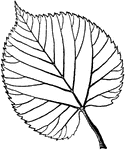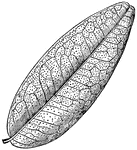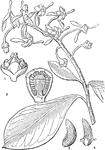
Ruyschia
"Ruyschia amazonica. 1. a calyx and pistil; 2. a section of the ovary; 3. a seed; 4. the same, with…

Hypericum
"Hypericum floribundum; 1. an entire flower; 2. a bundle of stamens; 3. a pistil with 3 carpels; 4.…

Egyptian Blue Lily
"Nymphaea coerulea. 1. a perpendicular section of a seed of N. alba; 2. half an embryo, showing the…
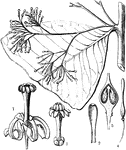
Aptandra
"Aptandra Spruceana. 1. an expanded flower; 2. a petal; 3. tube of stamens, with 4 petaloid glands at…

Arkansas State Capital
The Arkansas State capital Building, located in Little Rock, is the seat of government of the state…

Wells Cathedral, Somerset
Built between 1175 and 1490, Wells Cathedral has been described as "the most poetic of the English Cathedrals".…

Litsea
"Litsaea Baueri. 1. a male flower; 2. a female; 3. a stamen, with a gland at the base; 4. an anther,…
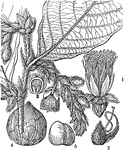
Couepia
"Moquileae canomensis. 1. a flower; 2. an ovary; 3. a perpendicular section of the last; 4. a fruit;…
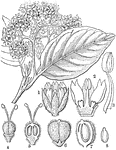
Chailletia
"Chailletia pedunculata. 1. a flower of Moacurra gelonioides; 2. a portion of it; 3. a stamen; 4. the…
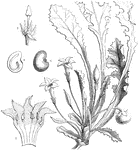
Pandanus
"Dorystigma. 1. a corolla laid open; 2. calyx and pistil; 3. seed; 4. section of ditto." -Lindley, 1853
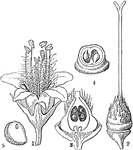
Bluntleaf Waterleaf
"Hydrophyllum canadense. 1. a flower; 2. a pistil; 3. a perpendicular section of the ovary; 4. a cross…
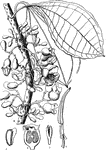
Medinilla
"1. Medinilla macrocarpa; 2. stamens of M. radicans; 3. perpendicular section of its ovary; 4. a section…

Myrtle
"Eugenia tuberculata. 1. a flower; 2. the same divided vertically; 3. a stamen; 4. a ripe fruit; 5.…
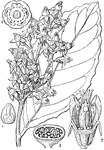
Byrsanthus
"Byrsanthus Brownii. 1. diagram of the flower; 2. section of a flower; 3. section across the ovary;…

Slow Match Tree
"Careya arborea. 1. one of the bundles of stamens; 2. a perpendicular section of the ovary; 3. section…
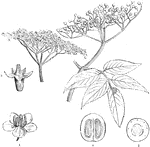
Elder
"Sambucus nigra; 1. a flower; 2. a young pistil; 3. a cross section of its ovary; 4. a perpendicular…

Mottled Dutchman's Pipe
"Aristolochia galeata. 1. fruit of an Aristolochia; 2. cross section of it; 3. half its seed." -Lindley,…

Stick Insect
The Phasmatodea (sometimes called Plasmodia) are an order of insects, whose members are variously known…

Oblong Leaf-Winged Grasshopper
Grasshoppers are herbivorous insects of the suborder Ceasefire in the order Orthoptera. To distinguish…

Pupa
Illustration of a pupa attached to a leaf. A pupa (Latin pupa for doll, pl: pupae or pupas) is the life…

White-marked Tussock Caterpillar
Orgyia leucostigma, the White-marked tussock moth, is a moth in the family Lymantriidae. The caterpillar…

Scaled Leaves
A variety of leaves with scales: "a, the scale-like leaves of the stem of Lathraea squamaria (toothwort);…
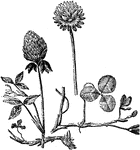
Clover
An illustration of white clover (left) and red clover (right). Clover (Trifolium), or trefoil, is a…
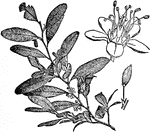
Coca Flower
Coca is a plant in the family Erythroxylaceae, native to north-western South America. The plant plays…

Anamirta cocculus
An illustration of an anamirta cocculus leaf. Anamirta cocculus is an Southeast Asian and Indian climbing…
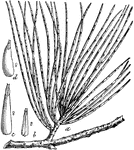
Pine Needle Scale
"a, Scales of Chionaspis pinifoliae upon pine-leaves, natural size; b, scale of male, enlarged; c, straight…

Watercress
Watercresses are fast-growing, aquatic or semi-aquatic, perennial plants native from Europe to central…

Date Palm Leaf
An illustration of a portion of a date palm leaf. The Date Palm (Phoenix dactylifera) is a palm in the…

Earthworm
An illustration of an earthworm. The basic body plan of an earthworm is a tube, the digestive system,…

Crocus
Crocus (plural: crocus, crocuses) is a genus of perennial flowering plants, native to a large area from…

Maryland Figwort
"The inflorescence of Maryland Figwort (Scrophularia Marylandica). a, the flower; b, the fruit; c, a…

Leaf Finial
The finial is an architectural device, typically carved in stone and employed to decoratively emphasize…

Leaf Indentations
An illustration of a fossil of a toothed fern. Ferns are vascular plants differing from the more primitive…

Self-Heal
"Self-heal. (Prunella vulgaris). The upper part of the stem with flowers. a, the calyx; b, the corolla;…
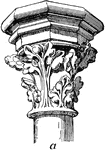
French Gothic Capital
A French Gothic capital from Sainte Chapelle in Paris from the thirteenth century. The capitals were…
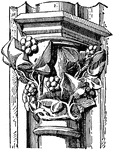
French Gothic Capital
A fourteenth century capital from transept of Notre Dame, Paris. The capitals were tall and slender,…

French Gothic Capital
A fifteenth century capital from the north spire of Chartres. The capitals were tall and slender, concave…

Leaf of Roman Diptych
An illustration of a roman diptych with gold leaf. A diptych is any object with two flat plates attached…
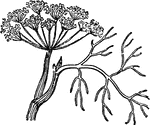
Dill
Dill (Anethum graveolens) is a short-lived perennial herb. It is the sole species of the genus Anethum,…

Sessile Bellwort
The Sessile Bellwort (Uvularia sessilifolia) is a species of bellworts, here showing its sessile leaves.

Grapefruit Leaf
The leaf of the Grapefruit tree (Citrus decumana) in the Rutaceae family of rues or citrus.

Sundew
The Sundews (Drosera rotundifolia) comprise one of the largest genera of carnivorous plants, with over…

Diseased Leaf
"Transverse section of a diseased patch in the leaf showing the hyphae of the fungus pushing between…
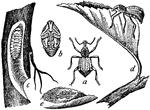
Apple Root Weevil
"Root-weevil (Leptops hopei). a, weevil; b, pupa; c, larva, in situ; d, weevil ovipositing on leaf above;…

Sedum
Sedum is the large stonecrop genus of the Crassulaceae, representing about 400 species of leaf succulents,…

Sagebrush
"Pasture Sage-brush (Artemisia frigida). a, leaf; b, flower-head; c, fertile flower; d, marginal flower."…

Canadian St. John's Wort
"Canadian St.-John's-wort (Hypericum Canadense). a, leaf; b, seed-capsule." -Whitney, 1911
Restored Capital from the Ruins of Persepolis
Other capitals are more compact, where from the lower part, which is in the shape of a globular vessel,…

Capital from the Ruins of Persepolis
Other capitals are more compact, where from the lower part, which is in the shape of a globular vessel,…
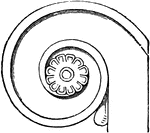
Volute of the Persian Column
Other capitals are more compact, where from the lower part, which is in the shape of a globular vessel,…

Acanthus Leaf, Front and Side Views
The acanthus is one of the most common ornaments used to depict foliage.





